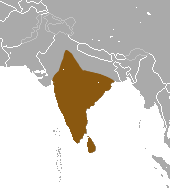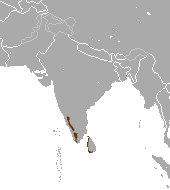Biology:Urva (genus)
| Urva | |
|---|---|
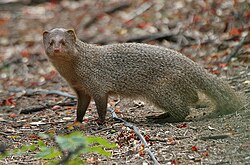
| |
| Indian grey mongoose | |
| Scientific classification | |
| Domain: | Eukaryota |
| Kingdom: | Animalia |
| Phylum: | Chordata |
| Class: | Mammalia |
| Order: | Carnivora |
| Suborder: | Feliformia |
| Family: | Herpestidae |
| Subfamily: | Herpestinae |
| Genus: | Urva Hodgson, 1837 |
| Type species | |
| Gulo urva Hodgson, 1836
| |
| Species | |
|
See table and range map | |
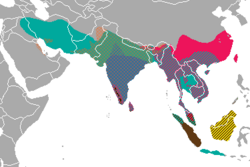
| |
Native distribution of Urva species
| |
Urva is a genus comprising the Asian mongooses within the mongoose family Herpestidae. Species in the genus were formerly classified in the genus Herpestes, which is now thought to comprise exclusively African mongooses; phylogenetic evidence indicates that the Asian mongooses form a monophyletic group and had an Asian common ancestor. Urva forms a clade with Xenogale and Atilax, while Herpestes forms a clade with all other African mongoose species.[1][2]
An Urva fossil specimen, an upper molar tooth, was excavated in the Ayeyarwady River valley in central Myanmar and is estimated to date to the late Pliocene.[3]
The scientific name Urva was coined by Brian Houghton Hodgson as the specific name of crab-eating mongoose in 1836,[4] and as the generic name in the following year.[5] Urva species have a wide distribution spanning from the Arabian Peninsula to the Indonesian island of Java.[6] The small Indian mongoose (U. auropunctata) has been introduced to several islands in the late 19th century, where it has become an invasive species.[7][8]
Species
Urva comprises the following species:[1]
| Image | Name | Distribution and IUCN Red List status |
|---|---|---|
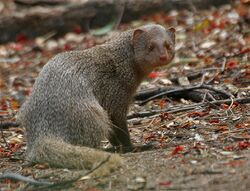
|
Indian grey mongoose (U. edwardsii) (Geoffroy Saint-Hilaire, 1818)[9] | LC[10]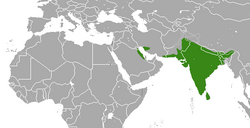
|
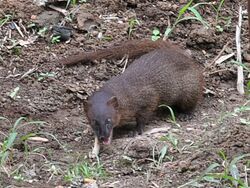
|
Javan mongoose (U. javanica) (Geoffroy Saint-Hilaire, 1818)[9] | LC[11]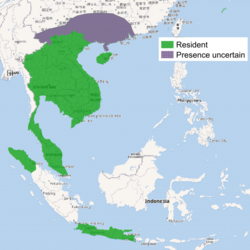
|
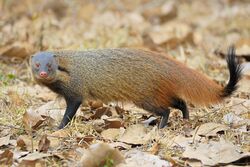
|
Stripe-necked mongoose (U. vitticolla) (Bennett, 1835)[12] | LC[13] |
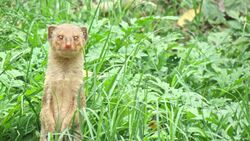
|
Small Indian mongoose (U. auropunctata) Hodgson, 1836[4] | LC[14]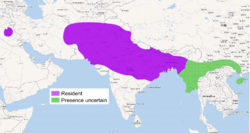
|

|
Crab-eating mongoose (U. urva) Hodgson, 1836[4] | LC[15]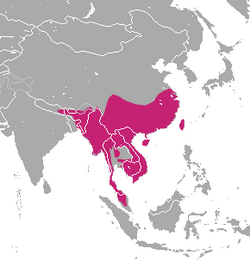
|
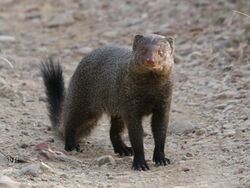
|
Ruddy mongoose (U. smithii) (Gray, 1837)[16] | LC[17] |

|
Short-tailed mongoose (U. brachyura) (Gray, 1837)[16] | NT[18]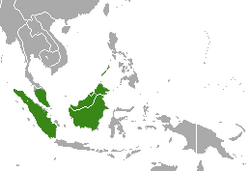
|
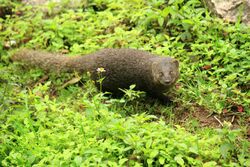
|
Indian brown mongoose (U. fusca) (Waterhouse, 1838)[19] | LC[20] |
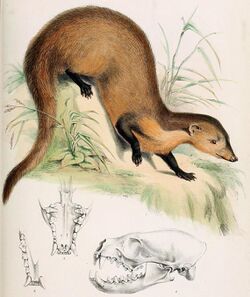
|
Collared mongoose (U. semitorquata) (Gray, 1846)[21] | NT[22]
|
References
- ↑ 1.0 1.1 Patou, M.; Mclenachan, P.A.; Morley, C.G.; Couloux, A.; Jennings, A.P.; Veron, G. (2009). "Molecular phylogeny of the Herpestidae (Mammalia, Carnivora) with a special emphasis on the Asian Herpestes". Molecular Phylogenetics and Evolution 53 (1): 69–80. doi:10.1016/j.ympev.2009.05.038. PMID 19520178. https://www.researchgate.net/publication/26286265.
- ↑ Zhou, Y.; Wang, S.-R.; Ma, J.-Z. (2017). "Comprehensive species set revealing the phylogeny and biogeography of Feliformia (Mammalia, Carnivora) based on mitochondrial DNA". PLoS ONE 12 (3): e0174902. doi:10.1371/journal.pone.0174902. PMID 28358848.
- ↑ Egi, N.; Nishioka, Y.; Tsubamoto, T.; Ogino, S.; Takai, M. (2011). "A mongoose remain (Mammalia: Carnivora) from the Upper Irrawaddy sediments, Myanmar and its significance in evolutionary history of Asian herpestids". Journal of Asian Earth Sciences 42 (6): 1204–1209. doi:10.1016/j.jseaes.2011.07.003. https://www.researchgate.net/publication/232411867.
- ↑ 4.0 4.1 4.2 Hodgson, B. H. (1836). "Synoptical description of sundry new animals, enumerated in the Catalogue of Nepalese Mammals". Journal of the Asiatic Society of Bengal 5 (52): 231–238. https://archive.org/details/journalofasiatic05asia/page/238/mode/1up.
- ↑ Hodgson, B. H. (1837). "On a new genus of the Plantigrades". Journal of the Asiatic Society of Bengal 6 (67): 560–565. https://biodiversitylibrary.org/item/123871#page/71/mode/1up.
- ↑ Veron, G.; Jennings, A.P. (2017). "Javan mongoose or small Indian mongoose – who is where?". Mammalian Biology 87 (1): 62–70. doi:10.1016/j.mambio.2017.05.006. https://www.researchgate.net/publication/317583330.
- ↑ Lowe, S.; Browne, M.; Boudjelas, S.; De Poorter, M. (2000). "Small Indian Mongoose (Herpestes javanicus (auropunctatus))". 100 of the World’s Worst Invasive Alien Species. A selection from the Global Invasive Species Database. New Zealand: The Invasive Species Specialist Group, SSC IUCN, Hollands Printing Ltd.. p. 10. http://www.issg.org/pdf/publications/worst_100/english_100_worst.pdf#page=9. Retrieved 2021-09-02.
- ↑ Louppe, V.; Lalis, A.; Abdelkrim, J.; Baron, J.; Bed’Hom, B.; Becker, A. A. M. J.; Catzeflis, F.; Lorvelec, O. et al. (2021). "Dispersal history of a globally introduced carnivore, the small Indian mongoose Urva auropunctata, with an emphasis on the Caribbean region". Biological Invasions 23: 2573–2590. doi:10.1007/s10530-021-02523-6.
- ↑ 9.0 9.1 Geoffroy Saint-Hilaire, É. (1817). "De l'Ichneumon. Ichneumon pharaon". Description de l'Égypte, ou, Recueil des observations et des recherches qui ont été faites en Égypte pendant l'éxpédition de l'armée française. Tome II. Paris: Commission des Sciences et Arts d'Egypte. pp. 137–144. https://archive.org/details/DescriptiondelEIIFranB/page/139.
- ↑ Mudappa, D.; Choudhury, A. (2016). "Herpestes edwardsii". IUCN Red List of Threatened Species 2016: e.T41611A45206787. https://www.iucnredlist.org/species/41611/45206787.
- ↑ Chutipong, W.; Duckworth, J. W.; Timmins, R.; Willcox, D. H. A.; Ario, A. (2016). "Herpestes javanicus". IUCN Red List of Threatened Species 2016: e.T70203940A45207619. https://www.iucnredlist.org/species/70203940/45207619.
- ↑ Bennett, E. T. (1835). "Remarks on some Mammalia from Travancore, including a New Species of Herpestes". Proceedings of the Zoological Society of London III: 66–67. https://archive.org/details/lietuvostsrmoksl33liet/page/n401.
- ↑ Muddapa, D.; Choudhury, A.; Punjabi, G. A. (2016). "Herpestes vitticollis". IUCN Red List of Threatened Species 2016: e.T41619A45208503. https://www.iucnredlist.org/species/41619/45208503.
- ↑ Jennings, A.; Veron, G. (2016). "Herpestes auropunctatus". IUCN Red List of Threatened Species 2016: e.T70204120A70204139. https://www.iucnredlist.org/species/70204120/70204139.
- ↑ Choudhury, A.; Timmins, R.; Chutipong, W.; Duckworth, J. W.; Mudappa, D.; Willcox, D. H. A. (2015). "Herpestes urva". IUCN Red List of Threatened Species 2015: e.T41618A86159618. https://www.iucnredlist.org/species/41618/86159618.
- ↑ 16.0 16.1 Gray, J. E. (1837). "Description of some or little known Mammalia, principally in the British Museum Collection". The Magazine of Natural History and Journal of Zoology, Botany, Mineralogy, Geology and Meteorology I (November): 577–587. https://archive.org/details/magazineofnatura101837loud/page/578.
- ↑ Mudappa, D.; Choudhury, A. (2016). "Herpestes smithii". IUCN Red List of Threatened Species 2016: e.T41617A45208195. https://www.iucnredlist.org/species/41617/45208195.
- ↑ Duckworth, J. W.; Mathai, J.; Ross, J.; Wilting, A. (2016). "Herpestes brachyurus". IUCN Red List of Threatened Species 2016: e.T41610A45206655. https://www.iucnredlist.org/species/41610/45206655.
- ↑ Waterhouse, G.R. (1838). "On two new species of Mammalia, from the Society's collection, belonging to the genera Gerbillus and Herpestes". Proceedings of the Zoological Society of London VI: 55–56. https://archive.org/details/proceedingsofgen36zool/page/n397/mode/2up.
- ↑ Mudappa, D.; Jathanna, D. (2015). "Herpestes fuscus". IUCN Red List of Threatened Species 2015: e.T41612A45207051. https://www.iucnredlist.org/species/41612/45207051.
- ↑ Gray, J.E. (1846). "New species of Mammalia". The Annals and Magazine of Natural History; Zoology, Botany, and Geology 18 (118): 211–212. https://archive.org/details/annalsmagazineof18lond/page/210/mode/2up.
- ↑ Mathai, J.; Hearn, A.; Brodie, J.; Wilting, A.; Duckworth, J. W.; Ross, J.; Holden, J.; Gemita, E. et al. (2015). "Herpestes semitorquatus". IUCN Red List of Threatened Species 2015: e.T41616A45208027. https://www.iucnredlist.org/species/41616/45208027.
External links
Wikidata ☰ Q99217654 entry
 |

